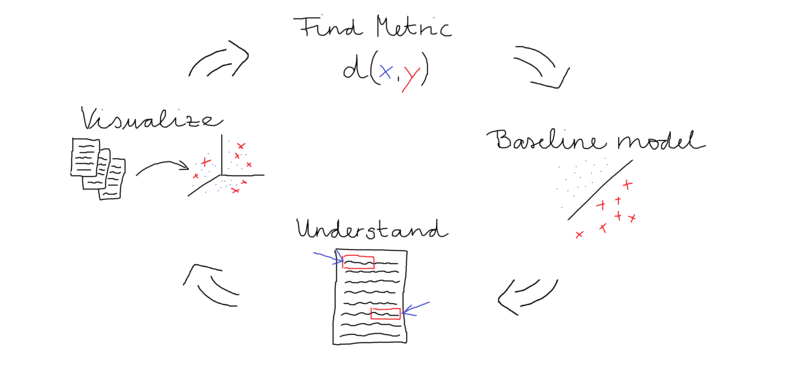How to approach almost any real-world NLP problem

This time, I’m going to talk about how to approach general NLP problems. But we’re not going to look at the standard tips which are tossed around on the internet, for example on platforms like kaggle. Instead we will focus on how to approach NLP problems in the real world. A lot of the things mentioned here do also apply to machine learning projects in general. But here we will look at everything from the perspective of natural language processing and some of the problems that arise there.

Precaution
We will focus mostly on common NLP problems like classification, sequence tagging and extracting certain kinds of information from a supervised point of view. Nevertheless, some of the things mentioned here also apply to some unsupervised problem settings.
Understand what you need to measure

An import and challenging step in every real-world machine learning project is figuring out how to properly measure performance. This should really be the first thing after you figured out what data to use and how to get this data. You should think carefully about your objectives and settle for a metric you compare all models with. In many cases it will be hard to measure exactly what your business objective is, but try to be as close as possible. If you craft a specific metric like a weighted or asymmetric metric function, I would also recommend to include a simple metric you have some intuition about. This helps to spot issues with potentially unreasonable values earlier.
Have a baseline
The most important thing is to have a simple, easily reproducible baseline.

If you are dealing with a text classification problem, I would recommend to use a simple bag of words model with a logistic regression classifier. If it makes sense, try to break your problem down to a simple classification problem. If you are dealing with a sequence tagging problem, I would say the easiest way to get a baseline right now is to use a standard one-layer LSTM model from keras (or pytorch). I would recommend to not spend a lot of time of hyperparameter selection. But of course make the baseline perform reasonable. For example, in a balanced binary classification problem, your baseline should perform better than random. If you cannot get the baseline to work this might indicate that your problem is hard or impossible to solve in the given setup. Make the baseline easily runnable and make sure you can re-run it later when you did some feature engineering and probably modified your objective. People often move to more complex models and change data, features and objectives in the meantime. This might influence the performance, but maybe the baseline would benefit in the same way. The baseline should help you to get an understanding about what helps for the task and what is not so helpful. So make sure your baseline runs are comparable to more complex models you build later.
Understand your data and the model

Text data can be hard to understand and whole branches of unsupervised machine learning and other technics are working on this problem. In our situation, we need to make sure, we understand the structure of our dataset in view of our classification problem. So I would recommend to look at the data through the lens of our baseline.
The questions we need to answer are:
- Is the preprocessing and tokenization appropriate?
- What kind of signal is the model picking up and does it make sense?
- Is there leakage, spurious signal or similar?
- How do the errors of the model look like? Do they make sense? Are they probably labeling issues or inconsistencies?
Now is the time to address these issues if you find some. Don’t jump to more complex models before you ruled out leakage or spurious signal and fixed potential label issues. Maybe you also need to change the preprocessing steps or the tokenization procedure. Simple models are more suited for inspections, so here the simple baseline work in your favour. Other useful tools include LIME and visualization technics we discuss in the next part.
Use visualizations heavily

A good visualizations can help you to gasp complex relationships in your dataset and model fast and easy. One approach can be, to project the data representations to a 3D or 2D space and see how and if they cluster there. This can be run a PCA on your bag of word vectors, use UMAP on the embeddings for some named entity tagging task learned by an LSTM or something completely different that makes sense.
But be careful, humans are very good at rationalizing things and making up patterns where there are none. Still visual inspection can guide the NLP development process.
Iterate!
Go back to the first step and redo and improve!
If you need to, increase the complexity of your model now. But make sure your new model stays comparable to your baseline and you actually compare both models.
Summary
- Pick an appropriate measure that reflects your business needs as close as possible.
- Build a simple and reproductible baseline pipeline and model.
- Use the baseline model to understand the signal in your data and what potential issues are.
- Leverage visualizations to understand the model and data
- Iterate!
The author of this article, Tobias Sterbak, is a data science expert and part of our freelancer community. If you are in need of highly skilled data science experts reach out to our expertmatch team.
Jul 2021 - 4 min read

Tobias Sterbak
Tobias Sterbak is a freelance machine learning consultant, providing state-of-the-art natural language processing and machine learning solutions for companies in multiple industries. He also shares his knowledge about machine learning and natural language processing on www.depends-on-the-definition.com.
